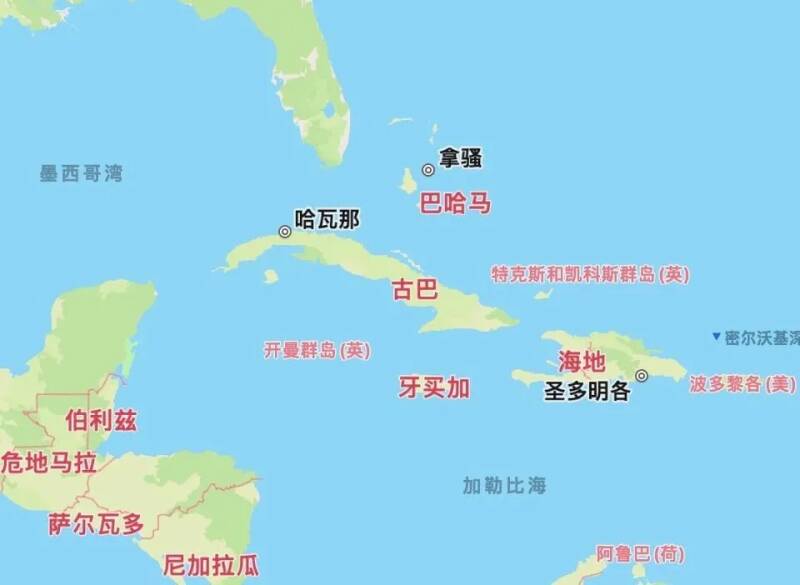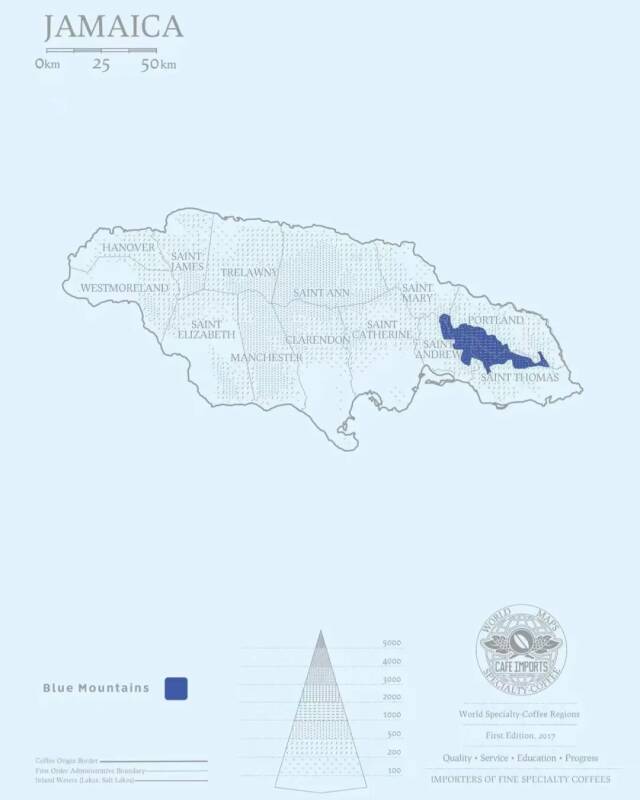What is the real Blue Mountain coffee? Are there any well-known manors in the Blue Mountains?
North America is the third largest continent in the world, which spans tropical, temperate and cold zones with a complex and diverse climate. Benefiting from the equatorial warm current in the Caribbean Sea in the southern part of North America, it is very suitable for crop growth. Due to suitable geographical and climatic conditions, coffee is grown in many island countries in the Caribbean, such as Cuba, Haiti, Dominica and Jamaica. Among them, although Jamaica produces little coffee, it is famous for producing Blue Mountain Coffee.

Located in the northwest of the Caribbean, Jamaica is an island country with alluvial plains in its coastal areas, hills and limestone plateaus in the middle and west, and blue mountains in the east. Surrounded by the Caribbean Sea, the Blue Mountain gets its name because the sun shines directly on the blue sea when the weather is clear, and the peaks reflect the bright blue light of the sea.
The highest peak of the Blue Mountain is 2256 meters above sea level, it is the highest peak in the Caribbean, and it is a volcano with fertile volcanic soil, fresh air, humid climate and perennial temperature around 27 ℃, which makes the world-famous Jamaican Blue Mountain Coffee.
Moreover, coffee cultivation in Jamaica has a long history, dating back to the 18th century, when the Governor of Jamaica, Nicholas Lawes, introduced Arabica coffee seeds from Martinique and planted them in St. Andrew. In the late 18th century, coffee cultivation areas spread from the St. Andrews area (St. Andrew) to the entire Blue Mountains (Blue Mountains). At that time, Jamaica had more than 600 coffee plantations, but because it was a British colony at that time, the coffee farms were controlled by the British, and the locals had to work in the park as slaves.
Until the early 19th century, when slavery was abolished, coffee farms were short of hands, and British preferential terms of trade to the colonies were lost, the coffee industry began to decline, and there were only 180 coffee plantations left in the 19th century.
However, the Jamaican government attached great importance to the development of the coffee industry and passed a decree in 1891 to teach producers knowledge about coffee cultivation in order to improve quality and improve infrastructure to enable coffee to be centrally processed and graded. The Central Coffee Clearing House (Central Coffee Clearing House) was also established in 1944, and all coffee must be approved by it before it can be exported.
In addition, the Jamaica Coffee Industry Council (The Jamaica Coffee Industry Board, referred to as CIB) was established in 1950, but the organization merged with other Jamaican commodity agencies in 2018 to form JACRA (Jamaica Agricultural Commodities Authority), and every barrel of Blue Mountain coffee beans must now be subject to quality control through JACRA. When it was founded, it also promulgated the "Coffee Industry Supervision Law", delineating the world-famous "Blue Mountain Coffee growing area".
According to the Coffee Industry Regulation Law, the Blue Mountain planting area is distributed in four areas: St.Andrew, St.Thomas, Portland and St.Mary. Only the coffee varieties grown in this area with an altitude of 915m-1700 m can be named Jamaican Blue Mountain Coffee (Jamaica Blue Mountain).

Blue Mountain Coffee is currently the only coffee exported in barrel packaging, only Jamaica Blue Mountain (No. 1, No. 2, No. 3, PB and Jamaican Alpine (Alpine Top, Alpine PB) can be used, with specifications of 70kg, 30kg and 15kg. Among them, the most advanced Lanshan No. 1 coffee must meet the specifications of more than 17 mesh, the proportion of defective beans can not exceed 2%, and the moisture content is about 10-12.5%. The lid of the barrel is marked with the trademark of Jamaican Blue Mountain Coffee, and other grades of Jamaican coffee are exported in 60 kg gunny bags.
There are many well-known coffee farms in this area that produce Blue Mountain Coffee, such as Clifton Manor Clifton Mount and Stoney Manor Stoneleigh.
Clifton Manor Clifton Mount started growing and producing coffee at Clifton Manor in the mid-18th century and is the only estate in Jamaica that has a "tropical rain forest (which must meet the standards of a sustainable agricultural system)" certification.
The coffee planting and processing area here falls on a hillside with an average elevation of 1300 meters above sea level, which is high enough, coupled with plenty of sunlight and fertile volcanic soil, to provide good conditions for coffee trees to grow. The Blue Mountain No.1 coffee on the front street is from Clifton Manor and tastes slightly citrus acid, with nutty and cocoa flavors, silky and well-balanced.
Stoney Manor Stoneleigh, located in St. Anrud, grows coffee at an altitude of 1642 meters. The estate was first established in 1889 as an experimental site for the British government, and then bought by Mr. Clair in 1956. After the reform of the government, the entire estate was renovated and the most advanced planting and roasting plant in Jamaica was established to produce high-stability and high-quality Jamaican Blue Mountain coffee.
Important Notice :
前街咖啡 FrontStreet Coffee has moved to new addredd:
FrontStreet Coffee Address: 315,Donghua East Road,GuangZhou
Tel:020 38364473
- Prev

Falling 70%! Ethiopia's exchange rate drops
According to local media reports in Ethiopia, on August 4 local time, the Ethiopian Coffee and Tea Authority signed a memorandum of understanding with the Oromi Asian Tourism Commission. According to reports, Ethiopia's coffee is world-renowned and is one of Ethiopia's main sources of foreign exchange earnings. And the memorandum of understanding
- Next

Ruixing Coffee launches a new joint product and is accused of "colliding" with the Overlord Tea Lady
▲ Click to pay attention| Daily Boutique Coffee Culture Magazine Coffee Workshop These days, Lucky has been very busy. He has invited artist Tan Jianji online to endorse instant soluble products, and he has co-branded "New Top Female Star"Loopy offline. On the one hand, he buys a celebrity set meal and gets the same coffee cup, and on the other hand, he buys a new product to give cuteness.
Related
- What is the standard process for the purpose of coffee cup testing? What is the difference between hand-brewed coffee and cup testing?
- How to use hand-brewed coffee paragon small golden balls? How does cold coffee lock in the aroma of coffee?
- Is American coffee black? What is the difference between American coffee and drip coffee?
- Unexpected! Well-known tea beverage brand Lele Tea will withdraw from the Zhengzhou market!
- Starbucks enters the fashion and beauty industry?! Netizen: Give me an ice American eye cream
- Why can American refills for free? The difference between Americano and American drip pot coffee
- Being chased out of the rain in front of Starbucks?! Store: Sheltering from rain under umbrellas poses a safety hazard
- The white moonlight has changed?! Lucky launches "Big Winter Pear American"
- Hand-brewed coffee three-stage method, high-sweet and universal brewing method to share! What does the high sweet water level of hand-brewed coffee mean?
- What is the difference between raw, refined and full espresso coffee? How to extract espresso and taste good?

